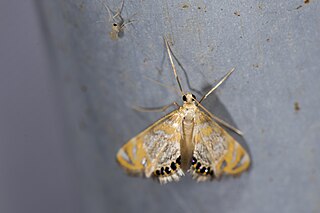
Cataclysta lemnata, the small china-mark, is a moth species of the family Crambidae. It is found in Europe, Morocco and Iran.

Parapoynx stratiotata, the ringed china-mark, is a moth of the family Crambidae. The species was first described by Carl Linnaeus in his 1758 10th edition of Systema Naturae. It is found in Europe where the distribution area extends in the north to the British Isles including Ireland and in the south to Sardinia, Sicily and Greece. The species is also found across the Palearctic in North Africa, Lebanon, Turkey, Azerbaijan, Kyrgyzstan, Uzbekistan and China..

Nymphicula is a genus of moths of the family Crambidae.
Paracataclysta is a monotypic moth genus in the family Crambidae described by Yutaka Yoshiyasu in 1983. Its single species, Paracataclysta fuscalis, was described by George Hampson in 1893. It is found in South-east Asia, northern Australia and Africa.

Parapoynx is a genus of moths of the family Crambidae described by Jacob Hübner in 1825.

Symmoracma is a monotypic moth genus of the family Crambidae described by Edward Meyrick in 1894. Its only species, Symmoracma minoralis, described by Snellen in 1880, is found in Indonesia, Papua New Guinea, Taiwan, China and Australia, where it has been recorded from Queensland.

Parapoynx fluctuosalis or Fluctuating China-mark or Waved China-mark, is a moth of the family Crambidae. It is a widespread species, known from Africa, India, Sri Lanka, China, Japan, Malaysia, Taiwan, Guam, Hawaii, Fiji, Australia and the Galápagos Islands. It is also an introduced species in Europe, where it has been recorded from Great Britain, the Iberian Peninsula and Sardinia.

Elophila obliteralis, the waterlily leafcutter moth, is a moth of the family Crambidae. It was described by Francis Walker in 1859. It is native to eastern North America. It is an introduced species in Hawaii and South Africa.
Elophila difflualis is a moth of the family Crambidae. The species was first described by Pieter Cornelius Tobias Snellen in 1880. It is found in South-East Asia, in Australia and Réunion but has also be introduced to the United Kingdom.
Elophila melagynalis is a species of moth of the family Crambidae. It was described by David John Lawrence Agassiz in 1978 from a specimen that was found in greenhouses of aquaristic plants in the United Kingdom but its exact origin was unknown. The author suggested the Far East. The presence of this moths has also been stated in Réunion, Japan, Sri Lanka and Thailand.
Argyrophorodes suttoni is a moth in the family Crambidae. It was described by David John Lawrence Agassiz in 2012. It is found in the Democratic Republic of the Congo.
Elophila africalis is a moth in the family Crambidae. It was described by George Hampson in 1906. It is found in Angola, Benin, Botswana, Cameroon, the Democratic Republic of the Congo, Ghana, Ivory Coast, Kenya, Madagascar, Malawi, Mozambique, Namibia, Niger, Nigeria, Senegal, Sierra Leone, South Africa, Tanzania, Uganda, Zambia and Zimbabwe.
Elophila minima is a moth in the family Crambidae. It was described by David John Lawrence Agassiz in 2012. It is found in Ghana, Kenya, Nigeria, Sierra Leone, South Africa and Uganda.

Eoophyla capensis is a moth in the family Crambidae. It was described by George Hampson in 1906. It is found in Angola, Cameroon, Ethiopia, Kenya, Liberia, Malawi, Mozambique, Namibia, Nigeria, South Africa, Tanzania, Uganda, Zambia and Zimbabwe.
Nymphicula hampsoni is a moth in the family Crambidae. It was described by David John Lawrence Agassiz in 2014. It is found in Australia, where it has been recorded from Queensland.
Parapoynx bipunctalis is a moth in the family Crambidae. It was described by George Hampson in 1906. It is found in Sudan, Uganda, the Democratic Republic of the Congo, Nigeria, Niger, Benin, Ivory Coast, the Gambia and Senegal.
Parapoynx ophiaula is a moth in the family Crambidae. It was described by Edward Meyrick in 1936. It is found in the south-eastern part of the Democratic Republic of the Congo and north-western Zambia.
Parapoynx plumbefusalis is a moth in the family Crambidae. It was described by George Hampson in 1917. It is found in Sudan, Uganda, Kenya, Tanzania, Zambia, Zimbabwe, Cameroon, Senegal, Nigeria, Niger, Sierra Leone, Angola, Botswana, Kenya and Madagascar.
Parapoynx zambiensis is a moth in the family Crambidae. It was described by David John Lawrence Agassiz in 2012. It is found in the Democratic Republic of the Congo, Botswana and Zambia.






